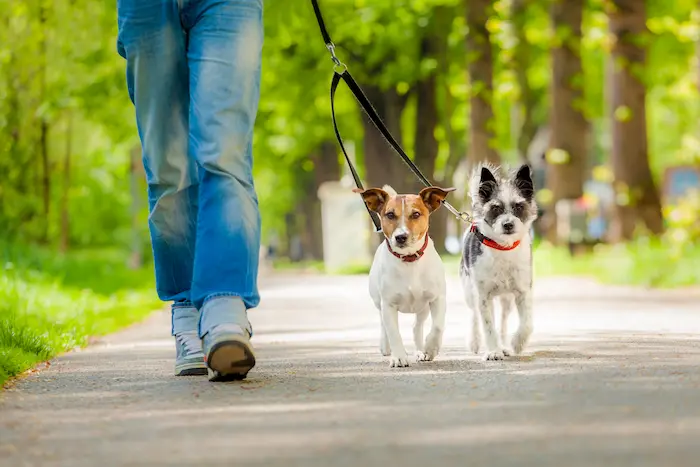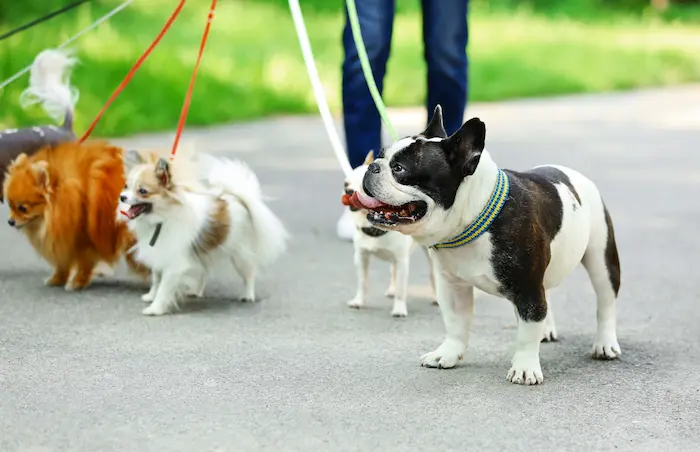
What Is Wireless Fencing for Dogs?
A dog leash is one of the most important supplies dog owners will purchase. But, with so many options available, it can be challenging to find the right leash for your pup. A certified professional dog trainer will probably tell you that the best dog leash is functional, suits your personal style, and works for your dog’s size, personality, and behavioral needs.
A few of the most common leash types are standard, retractable, and adjustable. Other dog leashes include slip leads, chain, and martingale leashes. There are also special leashes for riding a bike or taking a car ride with your dog, and these should be supplemental leashes you use for those occasions. Today, we’ll discuss how you can choose the very best dog leashes for your furry friends.
Factors to Consider When Choosing a Leash
You’ll want to consider many factors when choosing a dog leash. For example, large dogs require different styles of leashes than small dogs. In addition, training and behavior problems like pulling, the special requirements of service dogs, and the hyper responses of reactive dogs require different leashes. We’ve discussed these things in more depth below to help you decide the best dog leash for your canine.
The Size and Strength of Your Dog
Large Breeds
Large-breed dogs have a lot of strength and power behind them, so you must choose a durable leash that helps give you control while out and about. Examples of large-breed dogs include mastiffs, Dobermans, Great Danes, and St. Bernards.
A double-handle dog leash is especially great for large, powerful breeds because it gives you two control levels. If there’s a situation where you need to regain control of your big pup, you can grab the handle closest to your dog’s collar to keep them at your side. Other leashes that might work for large dog breeds include certain types of nylon leashes or reinforced standard leashes.
Small Breeds
Smaller dogs don’t require leashes as strong as their larger counterparts, but they do generally require a shorter leash length. Examples of small-breed dogs include Chihuahuas, dachshunds, Pomeranians, and pugs.
A traditional 6-foot leather or nylon leash is an excellent choice for smaller dogs. For the best results (and to keep your dog safest), pair this leash with a harness rather than a collar for your smallest pups.
Training and Behavior
Pulling
A special type of leash called an anti-pull leash is perfect for dogs that pull. This leash is attached to a harness by an O-ring at the front of the harness instead of the back. Once the leash is secured, your dog has to remain at your side to continue moving forward.
Can’t find an anti-pull leash? Consider using a shorter leash at first to keep your dog right at your side and give you more control. A training leash is also an excellent tool.
Reactive Dogs
Consider a head harness if your dog tends to react to people, other animals, or situations like seeing a car. These leash types fit over a dog’s mouth and ears and allow you to have more control without needing more strength. A double-handle leash is also a great idea, as it enables you to regain control quickly should you need to.
Service Dogs
A hands-free dog leash is an excellent choice for well-trained service dogs. These leashes allow the service dog to carry out its job without interference. A training leash or durable standard leash can be used when training service dogs.

What You Should Know About Dog Leashes
A dog leash is one of the most important supplies dog owners will purchase. But, with so many options available, it can be challenging to find the right leash for your pup. A certified professional dog trainer will probably tell you that the best dog leash is functional, suits your personal style, and works for your dog’s size, personality, and behavioral needs.
A few of the most common leash types are standard, retractable, and adjustable. Other dog leashes include slip leads, chain, and martingale leashes. There are also special leashes for riding a bike or taking a car ride with your dog, and these should be supplemental leashes you use for those occasions. Today, we’ll discuss how you can choose the very best dog leashes for your furry friends.
Factors to Consider When Choosing a Leash
You’ll want to consider many factors when choosing a dog leash. For example, large dogs require different styles of leashes than small dogs. In addition, training and behavior problems like pulling, the special requirements of service dogs, and the hyper responses of reactive dogs require different leashes. We’ve discussed these things in more depth below to help you decide the best dog leash for your canine.
The Size and Strength of Your Dog
Large Breeds
Large-breed dogs have a lot of strength and power behind them, so you must choose a durable leash that helps give you control while out and about. Examples of large-breed dogs include mastiffs, Dobermans, Great Danes, and St. Bernards.
A double-handle dog leash is especially great for large, powerful breeds because it gives you two control levels. If there’s a situation where you need to regain control of your big pup, you can grab the handle closest to your dog’s collar to keep them at your side. Other leashes that might work for large dog breeds include certain types of nylon leashes or reinforced standard leashes.
Small Breeds
Smaller dogs don’t require leashes as strong as their larger counterparts, but they do generally require a shorter leash length. Examples of small-breed dogs include Chihuahuas, dachshunds, Pomeranians, and pugs.
A traditional 6-foot leather or nylon leash is an excellent choice for smaller dogs. For the best results (and to keep your dog safest), pair this leash with a harness rather than a collar for your smallest pups.
Training and Behavior
Pulling
A special type of leash called an anti-pull leash is perfect for dogs that pull. This leash is attached to a harness by an O-ring at the front of the harness instead of the back. Once the leash is secured, your dog has to remain at your side to continue moving forward.
Can’t find an anti-pull leash? Consider using a shorter leash at first to keep your dog right at your side and give you more control. A training leash is also an excellent tool.
Reactive Dogs
Consider a head harness if your dog tends to react to people, other animals, or situations like seeing a car. These leash types fit over a dog’s mouth and ears and allow you to have more control without needing more strength. A double-handle leash is also a great idea, as it enables you to regain control quickly should you need to.
Service Dogs
A hands-free dog leash is an excellent choice for well-trained service dogs. These leashes allow the service dog to carry out its job without interference. A training leash or durable standard leash can be used when training service dogs.

Types of Dog Leashes
Although there are many types of dog leashes, the most common include the standard leash, retractable leash, and harness leash. Each of these is discussed more in depth below.
Standard Leash
A standard leash is likely the first thing that comes to mind when thinking of leashes. It has a loop on one end that you can hold or wrap around your wrist and a clip on the other. These come in various sizes and materials.
Pros of the standard leash include:
- They’re easy to handle.
- They work well for most dogs without behavioral issues.
- There’s a variety of materials, sizes, and leash lengths to suit your needs.
Cons of the standard leash include:
- They don’t work well with dogs that pull.
- They don’t offer additional control if necessary.
- Some types absorb moisture and are prone to wear and tear.
Breeds that do well with the standard leash include:
- Doberman
- Poodle
- Brittany
- Australian Shepherd
- Border collie
Retractable Leash
A retractable leash attaches to a harness or collar at one end and has a mechanism at the other that allows the leash to retract when you push a button. Although many people use them, retractable leashes aren’t recommended by experts because they can cause undue damage to a dog’s chest and neck.
Harness
A harness and leash wrap around the dog’s torso instead of its neck. Many people have begun to make the shift to this type of leash rather than a collar combo.
Benefits of the harness include:
- There’s a shift in pressure from the neck to the torso.
- They provide better control.
- They can be helpful for nervous dogs as they tend to feel more secure in the harness.
Disadvantages of the harness include:
- An ill-fitting harness can do more harm than good.
- They don’t work well with hands-free options.
- They may be time-consuming for everyday walks.
Breeds that do well with harnesses include:
- French bulldog
- Pug
- Chihuahua
- Pomeranian
- Shar-pei
A Dog Collar That Matches All Leash Types
Choosing a type of leash that fits your dog’s needs and your own style is crucial. The right leash can reduce pulling, relieve anxiety and reduce the risk of harm for reactive dogs.
No matter what type of leash is best for your pup, the Halo dog collar is a perfect match. The Halo dog collar allows for a life off-leash. With the Halo, you can easily turn fences on and off to create secure boundaries at home or elsewhere. Enjoy the best of both worlds—leash and off-leash experiences—knowing that your dog is safe, secure, and well-cared for.






